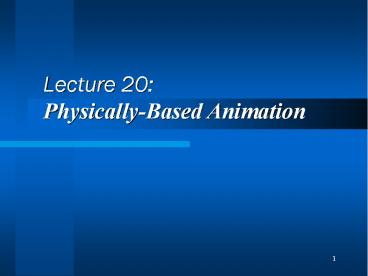Lecture 20: PhysicallyBased Animation - PowerPoint PPT Presentation
Title:
Lecture 20: PhysicallyBased Animation
Description:
Objects are animated by a procedure -- a set of rules. ... A fireworks pattern can be displayed by randomly generating particles within a ... – PowerPoint PPT presentation
Number of Views:156
Avg rating:3.0/5.0
Title: Lecture 20: PhysicallyBased Animation
1
Lecture 20Physically-Based Animation
2
Physically-Based Animation
- Idea to obtain a physically plausible animation,
simulate the laws of Newtonian physics. In
contrast to kinematics, this is called a dynamics
approach - Have to control objects by manipulating forces,
either directly or indirectly - Example bouncing balls, wall of bricks fall
down, etc - Inverse dynamics is difficult
3
Inverse dynamics
- Finding forces to move a physical object along a
desired path - Useful for secondary effects in keyframe
animation - A mouse characters ears should flap when it
shakes its head - A feather in a cap should wave when wind blows on
it - A wall of bricks should fall down when a
superhero crashes on it
4
Type of Physically-Based animation
- Procedural Animation
- Representational Animation
- Stochastic Animation
- Behavioural Animation
5
Type of animation - Procedural
- Control over motion by explicitly define the
movement as a function of time. - Objects are animated by a procedure -- a set of
rules. - The animator specifies rules and initial
conditions and runs simulation. - Rules are often expressed by mathematical
equations.
6
Type of animation - Procedural
- recursive algorithm to build the
binary tree
add leaves to the ends of the branches
3D - A more complex and realistic tree
7
Type of animation -Representational
- Specifying how a rigid object is to move in space
by allowing the object itself to change shape - Animation of articulated object
- Forward Inverse Kinematic
- Animation of soft object
- Animating on formation deformation of object
- Eg. stretching face muscles to create different
expressions - the realistic facial expressions of the creature
Gollum in "Lord of the Rings. - Morphing
8
Type of animation - Stochastic
- Features that generate large amounts of low-level
details - Eg. particle system
- often are used to simulate natural phenomena like
clouds, running water, fire, etc.
9
Type of animation - Behavioural
- Animate how object behave or interact with
environment naturally. - Eg animating birds flying
- Eg animating fishes living in their environment.
10
Type of animation - Behavioural
A flock of birds
A group of bugs - avoiding hitting the box
A group of fish reaching for oxygen
11
Particle Systems
- How do we model fuzzy objects? Object with
- soft boundary
- Changing boundary
- chaotic behaviour
- Eg clouds, fire, water, grass, fur
12
Particle Systems
- Basic idea model fuzzy or gaseous objects as
large collection of particles - Animate fuzzy or gaseous objects as a changing
cloud of particles - Aim for overall effects by having many, simple
particles
13
Particle Systems
- Each particle has properties
- Geometry (point, line, sphere)
- Position
- Velocity vector
- Size
- Colour
- Transparency
- State
- lifetime
14
Particle Systems
- Animating Particles Systems
- New particles are born, old ones die
- State information describes type of particle
- At each time step, based on state
- Update attributes of all particles
- Delete old particles
- Create new particles
- Display current state of all particles
15
Particle Systems
- Particle Systems Details
- Good for describing objects that change over time
by flowing, spattering or expanding - Often will model gravity when updating particles
- Render fire etc using transparency brighter
when particle system denser - As each particle moves, its path is plotted and
displayed in a particular color.
16
Particle Systems
- Example 1
- A fireworks pattern can be displayed by randomly
generating particles within a spherical region of
space and allowing them to move radially outwards
as shown in next figure. The particle paths can
be color from red to yellow, to simulate the
temperature of exploding particles.
17
Particle Systemseg Fireworks
Source http//www.maylin.net/Fireworks.html
18
Particle Systems
- Example 2
- A realistic displays of grass clumps have been
modeled with trajectory particles that are shot
up from the ground and fall back to earth under
gravity. - In this case, the particle paths can originate
within a tapered cylinder, and might be color
from green to yellow
19
Particle Systemseg Plant
20
Particle Systems
- Example 3
- A waterfall system
- The water particles fall from a fixed elevation,
are deflected by an obstacle, and then splash up
from the ground.
21
Particle Systemseg Waterfall































